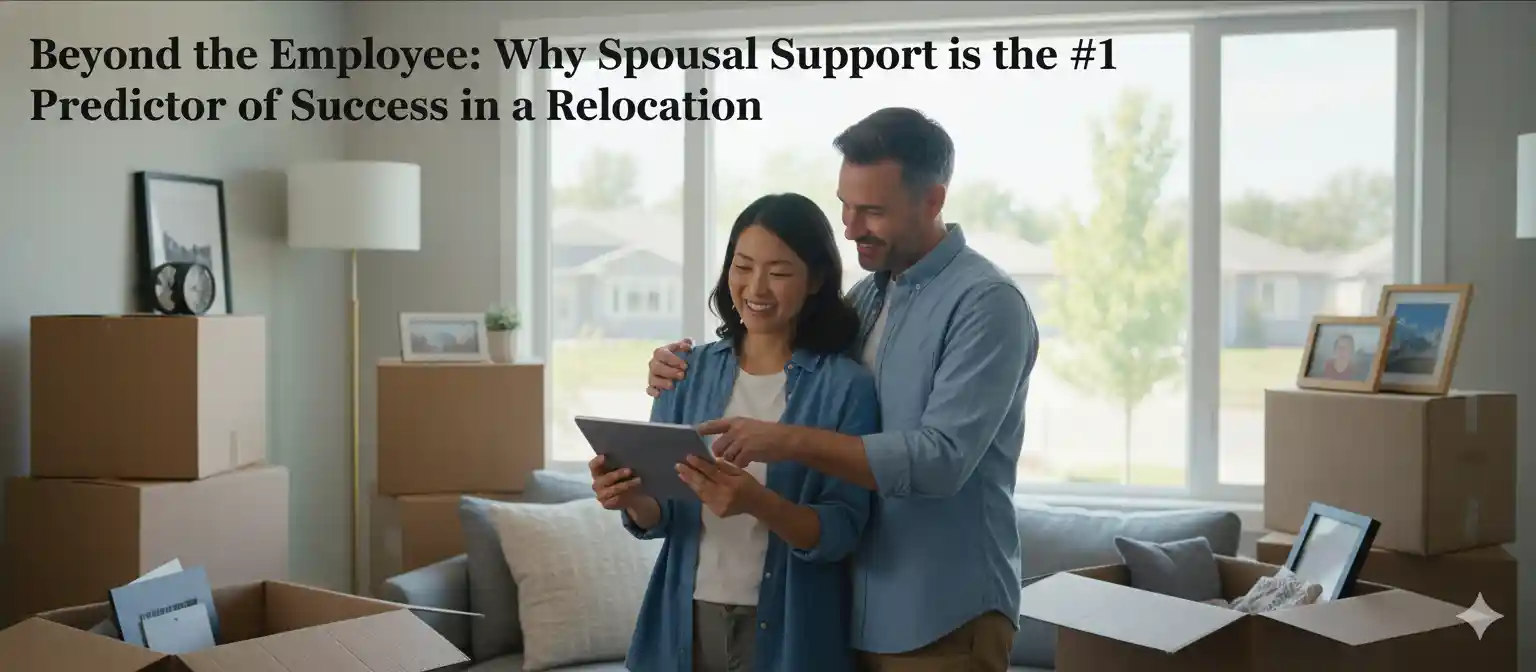E.E. Ward Moving & Storage
Why up to 40% of corporate relocations fail and how HR can fix it

The success of an employee relocation hinges not on logistics, but on a strategic shift in the HR professional's role from a 'move coordinator' to a 'transition architect.' This guide explains how focusing on the human factors of a move—such as family integration, spousal support, and community belonging—is the key to preventing costly failures, improving employee retention, and maximizing the return on your talent investment.
The 40% failure rate: Redefining relocation ROI beyond the moving truck
For decades, the traditional HR checklist for employee relocation has been a model of logistical efficiency. It covers the essentials: managing household goods moving services, securing corporate-sponsored temporary housing solutions, and processing the paperwork. This approach treats corporate relocation as a transaction, a simple movement of a human asset from point A to point B. But a growing body of evidence, and our own extensive experience, shows this view is dangerously incomplete. The real challenges in corporate relocation management surface after the boxes are unpacked.
Industry studies suggest that as many as 40% of all corporate moves are considered failures within two years. Failure isn’t just an employee deciding to move back home; it’s a spectrum that includes significant underperformance, disengagement, or the employee leaving the company for another opportunity in their new city. When you start measuring the ROI of a relocation program, you realize the cost of a moving truck is dwarfed by the immense hidden costs of a failed placement. These include sunk recruitment expenses, thousands of hours in lost productivity as the role sits vacant again, and the corrosive effect on team morale. The focus must shift from simply managing a move to engineering a successful transition.
HR as 'Move Coordinator' vs. 'Transition Architect': A Tale of Two Approaches
The distinction between these two roles is the central theme of this corporate relocation guide for human resources. Understanding it is the first step toward updating an employee relocation program for the modern workforce.
The 'Move Coordinator' (Logistics/Policy Focus)
The Move Coordinator operates from a transactional mindset. Their primary role is the efficient administration of a static policy. Success is measured by staying on budget, meeting deadlines, and ensuring all logistical tasks are completed. This professional is an expert in negotiating with corporate relocation vendors and understands the ins and outs of budget tracking for employee relocation.
- Focus: Policy enforcement, vendor management, expense processing.
- Tools: Spreadsheets, HR checklist for employee relocation, vendor contracts.
- Metrics: Cost per move, days to complete move, policy compliance.
- Employee Experience: Often feels transactional and impersonal. The employee and their family are left to navigate the most difficult personal aspects of the move on their own. This can lead to stress and a feeling of being unsupported.
The 'Transition Architect' (Human Factors Focus)
The Transition Architect sees the move as a critical phase in the employee lifecycle. They understand that a new hire relocation support plan must extend beyond the physical move to address the employee's entire life ecosystem. They proactively manage the human experience, knowing that an employee's focus and productivity depend on their family's stability and happiness. This approach is fundamental to employee retention strategies for relocated staff.
- Focus: Employee and family well-being, community integration, long-term retention.
- Tools: Corporate mobility technology platforms, employee relocation satisfaction surveys, pre-decision services for employee relocation, destination services.
- Metrics: Employee retention rate at 12 and 24 months post-move, employee engagement scores, time to full productivity in the new role.
- Employee Experience: Feels holistic, empathetic, and supportive. The company is seen as an invested partner in the family's success, building immense loyalty and trust from day one.
The core difference lies in the definition of success. For the Coordinator, success is the employee arriving on time and on budget. For the Architect, success is that same employee thriving in their role and life a year later, fully integrated and committed to the company's future.
Beyond the employee: Why spousal support is the #1 predictor of success

If there is one single factor that can predict the outcome of a corporate relocation, it is the happiness and integration of the employee's spouse or partner. We have seen countless moves succeed or fail on this point alone. When an employee is focused on their new role and professional onboarding process, their partner is often left to single-handedly rebuild their family’s entire social and, often, professional life in a new state. This is an immense undertaking.
In fact, according to researchers, a significant challenge for relocating families is finding employment for the employee's spouse or partner. A trailing partner who leaves behind a career, a network of friends, and a support system can quickly feel isolated and resentful, creating immense pressure at home. This stress invariably spills over into the employee's work life, impacting focus, performance, and their long-term view of the move. This is why family and spousal support in corporate relocation cannot be an afterthought; it must be a primary focus of any support package.
Modern relocation support for diverse talent and executives alike should include services like:
- Career coaching and resume assistance for the partner.
- Networking introductions within their professional field.
- Information on local professional organizations and certifications.
- Support in navigating business licensing or continuing education in the new location.
By investing in the partner’s transition, you are directly investing in your employee’s success and demonstrating a profound duty of care in employee relocation that builds lasting loyalty.
Architecting the first 90 days of 'life onboarding'
A successful transition isn't just about the first day of work; it's about the first 90 days of life in a new place. The goal is to shrink the time it takes for a new city to feel like "home." A Transition Architect helps build a support plan that extends far beyond the office walls, a process we call "Life Onboarding." This is about making connections and building community.
This proactive support is crucial because many people are uncomfortable asking for help. Some employees are hesitant to ask for relocation assistance because they want to appear as if they were planning the move regardless, especially if competing with local candidates. A structured Life Onboarding process removes this barrier by making support the default standard.
This is where comprehensive destination services for relocating employees become invaluable. Instead of just handing an employee a welcome packet, an architect helps connect them to the fabric of their new community. Essential components include:
- School Search Assistance for Employee Families: Providing detailed reports on public and private schools, arranging tours, and helping with the enrollment process is one of the most powerful ways to reduce family stress.
- Community Integration: This means connecting the family with resources based on their hobbies and interests. This could be anything from local sports leagues and arts programs to volunteer organizations and religious communities. The goal is to help them rebuild their social network.
- Local Expertise: Providing access to trusted local guides who can offer practical advice on everything from finding the best family doctor to navigating local traffic patterns and understanding neighborhood personalities. This is a key part of improving the employee relocation experience.
- Real Estate Assistance for Relocating Employees: Beyond just finding housing, this involves connecting them with vetted real estate professionals who understand the unique pressures and timelines of a corporate move, including home sale assistance for employees leaving their old residence.
A powerful example of how personal factors drive these decisions is the case of a professional who chose to relocate. His decision to move to Austin, Texas was driven by a perfect storm of factors: the presence of a local company office, no state income tax, and, critically, the fact that his wife's family was already in the city. This highlights that career is often just one piece of a much larger personal puzzle. A successful talent mobility strategy and planning process must account for the whole picture.
From lump sum to flexible tiers: Designing modern, empathetic policies
For years, the "one-size-fits-all" relocation policy was standard. A company would offer a lump sum relocation package or a rigid set of benefits to every employee, regardless of their life stage or needs. This approach is not only inefficient but can feel impersonal and inadequate. A 22-year-old single renter has vastly different needs than a 45-year-old homeowner with three children and a trailing spouse. A modern, effective relocation policy must be flexible.
This is why many companies are moving toward a tiered relocation policy or a core/flex model. This approach offers a baseline of support for all employees (the "core" benefits, such as managing household goods moving services) and a menu of flexible options that employees can choose from based on their unique circumstances.
Key Components of a Modern Relocation Policy:
- Core/Flex Relocation Policy Benefits: This structure provides cost control for the business while delivering personalized support for employees. It allows them to allocate funds where they need them most, whether it's for pet relocation services for corporate moves or cross-cultural training for international assignees.
- Clear Tax Guidance: HR professionals must understand the tax implications of employee relocation benefits. The IRS requires companies to report these payments as taxable income. Explaining what a relocation gross-up is (an additional payment to help offset the tax burden) is a critical part of how to communicate a relocation package to an employee clearly and transparently.
- Handling Exceptions: No policy can cover every eventuality. A good policy includes a clear process for managing exceptions to relocation policy, ensuring fairness and consistency while allowing for flexibility when necessary.
- Legal and Compliance Awareness: Legal compliance in employee relocation is crucial. Policies must be written carefully, and HR professionals should be aware of specific state-level rules, such as how California defines reimbursable expenses for state employees as those incurred fifty miles or more from their home.
Streamlining the employee relocation process with technology is also essential. Modern relocation management software for HR and assignment management software can help manage these complex, tiered programs, providing visibility into costs and improving the overall experience for both the HR team and the relocating employee. Whether you're considering corporate relocation for remote workers or managing a large group move, technology provides the backbone for an efficient and empathetic process.
Making the right choice for your needs
Shifting from a logistics-focused to a human-focused relocation strategy is a significant change. The best approach for your organization depends on your priorities, resources, and company culture. Our experience, reflected in our 4.8 rating from over 600 reviews, shows that a tailored strategy is always best.
For the Logistics-Focused Manager
If your primary concerns are budgets, timelines, and compliance, your goal is predictability and control. You view relocation as a key operational function. Your best first step is not to abandon your process, but to enhance it. Start by measuring the true cost of failure. Track retention rates for relocated employees at the 12 and 24-month marks. Use this data to calculate the ROI of investing in a few high-impact "human factor" services, like spousal career support. A small, targeted investment here can prevent the massive cost of a failed placement, delivering a clear and compelling return that aligns with your focus on corporate relocation cost management strategies.
For the People-First HR Business Partner
You already understand that a positive employee experience is paramount. Your focus is on culture, engagement, and retention. For you, the 'Transition Architect' model is a natural fit. Champion the adoption of a core/flex relocation policy. This empowers employees with choice and demonstrates empathy for their individual situations. Your key initiative should be to build out a comprehensive "Life Onboarding" program. Start by surveying recently relocated employees to identify pain points and build a network of trusted local resources for everything from childcare to community groups. You will be the driver of improving the employee relocation experience and making your company a magnet for talent.
For the Talent Acquisition Specialist
In a competitive market, you know that the offer package is a critical closing tool. Using relocation as a talent acquisition tool can be your key differentiator. You understand why a relocation policy is important for recruiting top candidates. Frame the relocation support not as an administrative process, but as the company’s first and most significant investment in the candidate's success. When negotiating with a top candidate, lead with the "Transition Architect" benefits. Talk about spousal career assistance, school search support, and community integration. This demonstrates a level of care that goes far beyond salary and bonus, showing the candidate that you are invested in their family's entire well-being, which can be the single factor that gets the offer signed.
Ultimately, a successful employee relocation is one where a talented professional and their family feel supported, connected, and confident in their new life, allowing them to bring their best selves to their new role. For 144 years, since our founding in 1881, we have built a legacy on this principle of trusted, professional service. We have seen firsthand that when you manage the human transition with the same care you manage the physical move, you create a powerful foundation for long-term success. If you are looking to evolve your corporate mobility program and see how a human-centric approach can benefit your business, contact the team at E.E. Ward Moving & Storage in Columbus, OH for a personalized consultation.
Get a Quick Estimate For Your Upcoming Move!
We are here to help! Fill out our Quick Moving Estimate inquiry form and our team will contact you soon with a free estimate. Contact the office moving company with over a century of moving experience. Whether it’s a local downtown move or long-distance relocation — including business moves — we’re ready to help.



